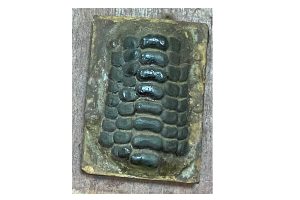Cast of vomerine teeth – Coelodus gyrodoides, Egerton
Type status : Holotype, NHM , London,UK.
Phylum – Chordata
Order – Pycnodontiformes

Formation – Upper Greensand Formation
Country – United Kingdom
Continent – Europe
Class- Osteichthyes
It carries five rows of tritorial teeth. The central series is composed of eight reniform teeth (Kidney shaped). They have an elongated sulcus on the anterior face of each tooth similar to those which characterize the mandibular teeth of Coelodus. The adjoining rows on either side have nine teeth on the right side and eight on the left. They are considerably smaller than those of the centre row and more obtuse. The depression on the grinding surface is larger in proportion to the area of the tooth, and each pit has a single papilla at the bottom of the cavity. The two outer rows contain seven teeth in the right and six in the left. These are smaller than those in the adjacent rows and more oval in shape with a slight truncation of the outer margin.
Gault Formation is a geological Formation of stiff blue clay deposited in a calm, fairly deep-marine environment dining lower Cretaceous period ( upper and
Middle Albian age ). It is well exposed in the coastal cliffs. It over lays the Lower Green sand formation and underlies the upper Greensand formations.
The late Cretaceous ( Cenomanian- Maastrichtian) English chalk and Eocene (Ypresian) London clay are two fossiliferous British Marine deposits that are significant in the history of palaeontology generally and palaeoichthyology specifically. The actinopterygians ( ray-finned fishes) of the chalk and London clay are notable not diversity, but also for their remarkable preservation. Unlike most fish faunas of comparable age, in which specimens are preserved as greatly flattened compression fossils, these British deposits yield three-dimensionally preserved specimens of either whole individuals (chalk ) or heads(London Clay). The popularity of fossil hunting in the London clay during the mid 1800 s led to James Bowerbank’s foundation of the London clay club(1836-47), which eventually give rise to the modern palaeontographical society. The English chalk and London clay provided ample material for study and description by Arthur Smith Woodward. Natural History Museum,London houses the finest collection of fossil fishes from there localities.
Source
Geological Magazine Decade II , Vol No.2 . February, 1877.
